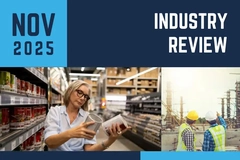
- Industry news
Industry news
- Category news
- Reports
- Key trends
- Multimedia
Multimedia
- Journal
- Events
- Suppliers
Suppliers
- Home
- Industry news
Industry news
- Category news
- Reports
- Key trends
- Multimedia
Multimedia
- Events
- Suppliers
Suppliers
Flexible Packaging Europe: Industry concerned by raw material deficits as COVID-19 recovery surges demand

25 Jun 2021 --- Flexible Packaging Europe (FPE) is warning continuing raw material availability issues are creating a potential risk to the stable supply of food, pharmaceutical and medical products.
Guido Aufdemkamp, FPE’s executive director, tells PackagingInsights the general COVID-19 economic recovery has increased the demand for all raw materials across all sectors worldwide. However, polymer supply issues are creating challenges for the value chain.
“Various force majeure declarations and maintenance announcements have squeezed the situation for polymers,” explains Aufdemkamp.
“In aluminum, the global recovery of production in automotive and other transportation, construction and rigid packaging combined with reduced primary capacity has created a general material deficit.”
“The shortages in global but also European transport logistics adds to the issues.”
IVK Europe (the European plastic sheets and films association) has also warned of ongoing raw material shortages and rising prices in the plastics industry.
Historic demand for raw material
According to data from Wood Mackenzie’s quarterly flexible packaging overview, rates of all raw materials used for flexible packaging showed a historic increase over the past six months.
Examples of these drastic shifts include a more than 130 percent demand increase for polyethylene resins, almost 70 percent for BOPP film and 18 percent for aluminum foil.
Additionally, freight rates for sea from and to Europe and land transportation within Europe rocketed.
“The strong increase across all materials hits not exclusively the flexible packaging industry but all industries,” notes Rob Gilfillan, head of applications at Wood Mackenzie.
“The main reason is the immediate and simultaneous recovery everywhere in the world and most sectors toward the end of the pandemic.”
“Any unforeseen incident like seaway blockages, production interruptions and other unfortunate circumstances could immediately worsen the precarious situation.” According to Wood Mackenzie, rates of all raw materials used for flexible packaging showed a historic increase over the past six months.
According to Wood Mackenzie, rates of all raw materials used for flexible packaging showed a historic increase over the past six months.
Raw material in short supply
At its summer meeting this month, more than three-quarters of participating FPE members rated the current availability of raw materials as “bad” or “very bad.”
The expectations for the raw material price developments diverged from “further increase” (23%) to “stable” (41%) and “decrease” (36%).
“The concourse of basically all materials necessary for production is creating major issues and complexities for our member companies,” continues Aufdemkamp.
“The manufacturers are doing their utmost to serve customers in the best possible way, but it is continuously difficult as the availability is tightening further.”
“This challenging situation is anticipated to last until the end of the year while we hope there will be no further supply chain or geopolitical hick-ups.”
He adds the ongoing shortage might ultimately be reflected in product delivery bottlenecks and price adjustments in retail, affecting end-consumer costs.
Light at the end of the tunnel?
Aufdemkamp tells PackagingInsights once the sudden and strong recovery levels to a more regular growth path, raw material availability should return to relative normality.
“However, it is very difficult to predict a concrete timeframe, in particular, while having several disruptions, such as the Suez Canal blockage or other incidents in the past months, which show how sensitive the global supply chain is.”
Almost half of the FMCG in Europe, excluding beverages, are packed with flexible packaging, FPE indicates.
Examples include various packaged foods, pet food, personal care and household products, and pharmaceuticals.
By Joshua Poole











